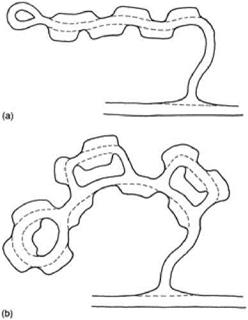This is usually a one-way system, but may be two-way if need be. The simplest layout consists of a loop road along which are spaced bays capable of holding between three and seven cars. These may be all on the one side of the circuit (either exterior or interior) or on both the exterior and the interior sides. In the latter case they should normally be staggered. Multiple loops may be used in various combinations, depending on the site and the capacity. Such car parks tend to fill up from those areas nearest the main focus of the site, so the layout should allow for short alternative loops so that cars do not have to go right round again if part of the parking area is full. The advantages of this type of layout include the ease with which it can be extended, either by enlarging parking bays or adding extra loops. It is often a good idea to plan for additional parking from the outset, so that if demand increases quickly, enlargements can be made quite easily without a major redesign.
The loop layout is especially suited to fairly flat forested landscapes, where the road can wind its way amongst the trees and bays can be tucked in between them. It does require a significant amount of room, although quite dense layouts are possible in more open landscapes.
Loop layouts are also good when passengers need to be dropped off from coaches. A drop-off zone can be provided near the focus of the site, and the coach can then be driven to a special parking area away from most of the cars. This prevents coaches from dominating the site or becoming a safety hazard. Equally, where boats or other large equipment need to be delivered they too can be located in a special storage area on the access section before the empty vehicle moves on into the car park. One requirement is that longer vehicles or those with trailers need larger bays, which must be clearly identified: pull-through parking is not so easy to accommodate with this layout.
|
(a) This linear layout is suited to terraces or side slopes, where it is aligned along the contour. A turning loop is provided. The layout must operate a two-way traffic system. (b) This version has greater capacity, with small loops giving greater bay numbers and the use of the turning loop for parking. |




